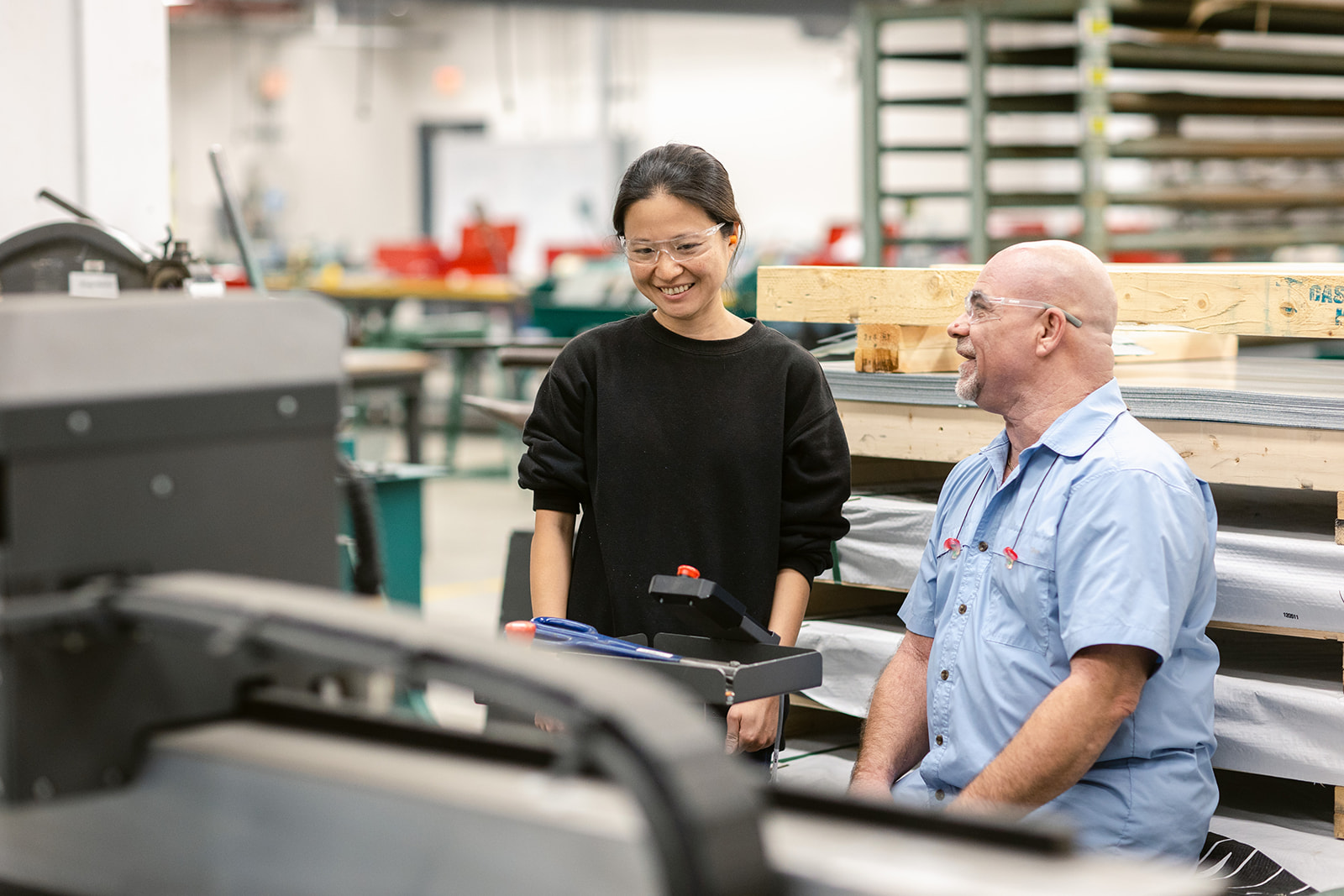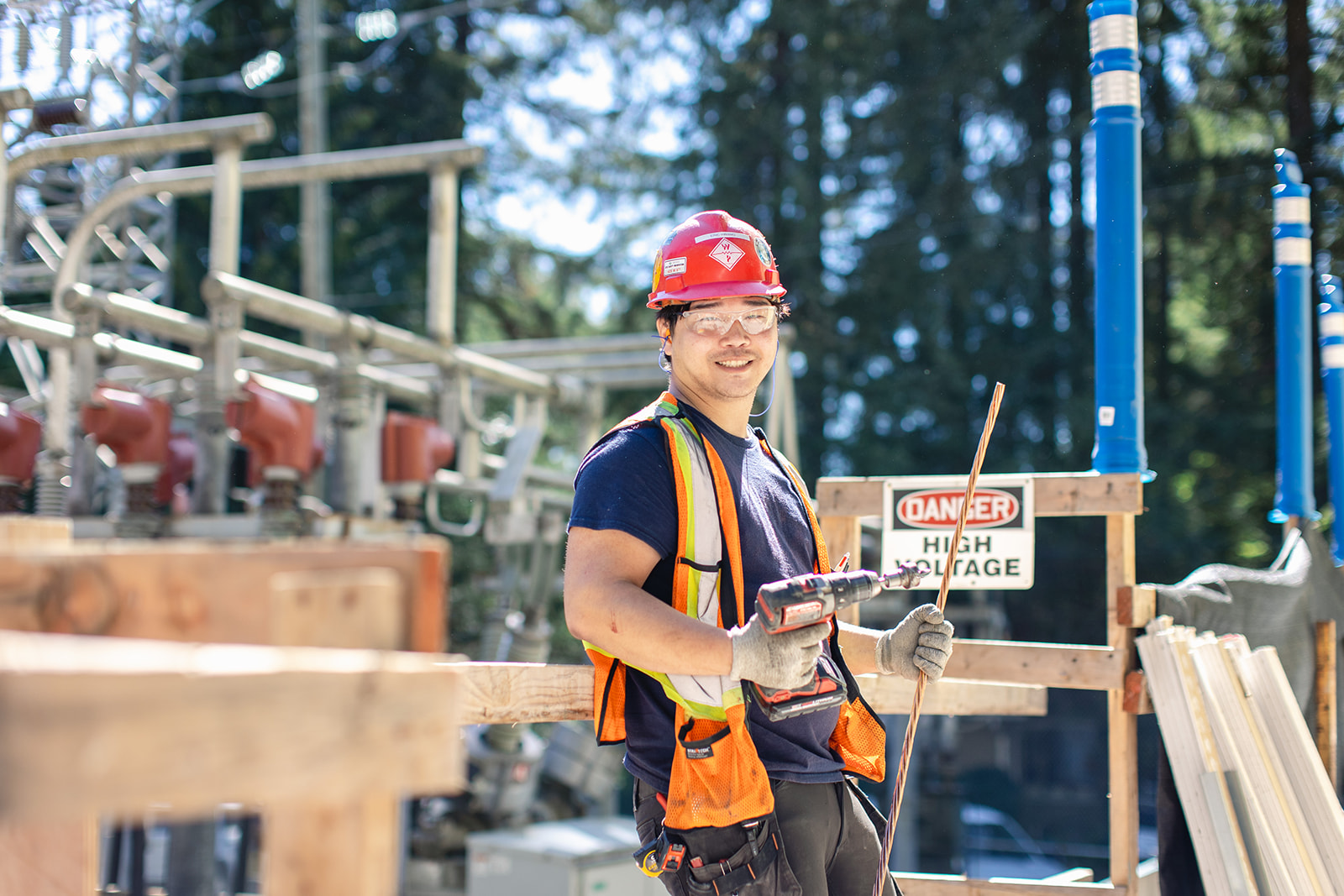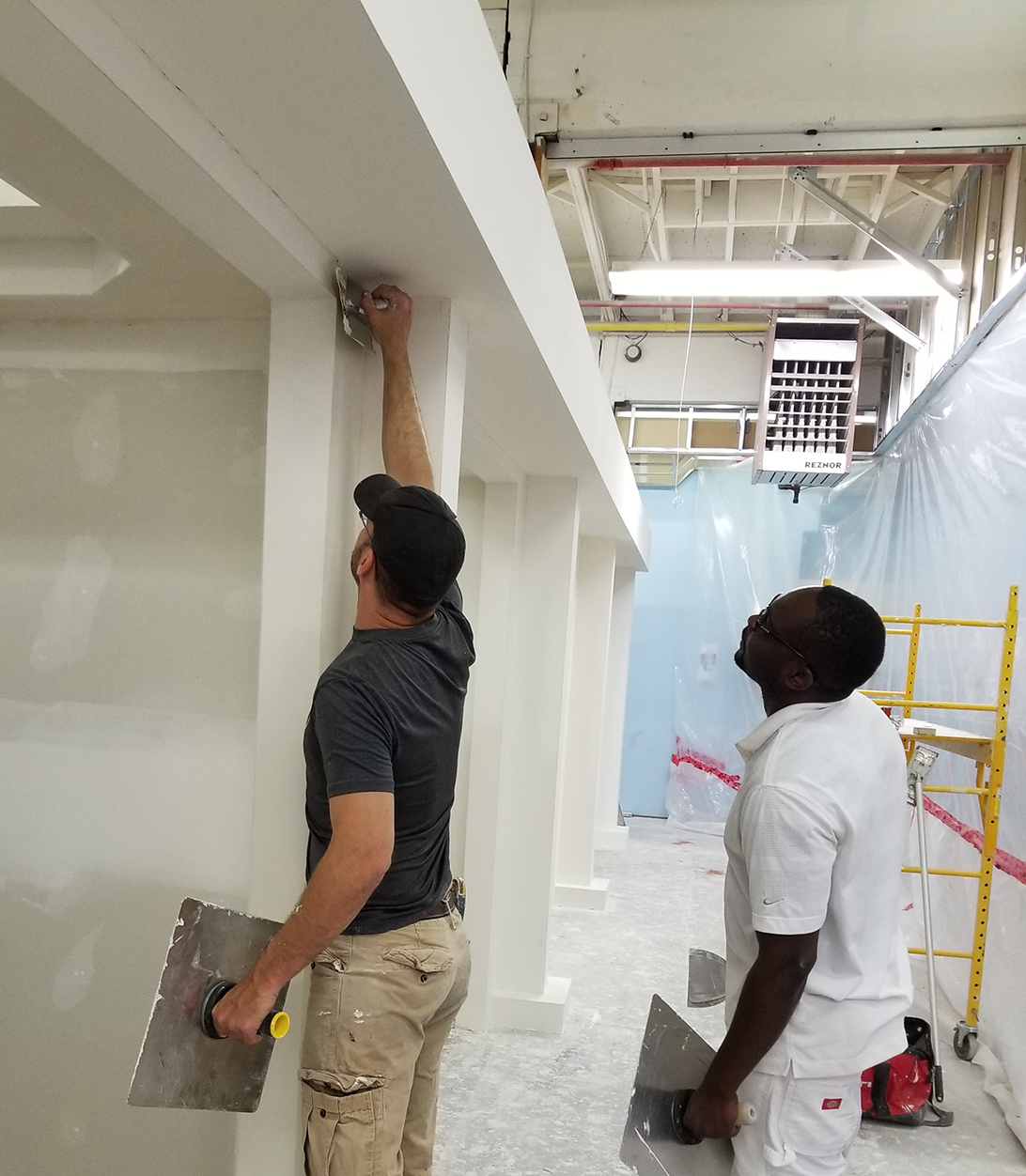Metal Fabricator (Fitter) Endorsement: Marine Fitter
Metal Fabricator (Fitter)
Endorsement:
Marine Fitter

- How to identify shipbuilding processes
- How to implement safe work practices and work in hazardous environments
- How to read construction drawings
- How to create lofts
- How to assemble and repair ship structures, outfit ships, and erect hull blocks
Marine Fitters are precise and tactile tradespeople who enjoy working closely with metal pieces, machinery and equipment to assemble, construct and repair ships.
As a Marine Fitter, you’ll build, assemble and repair products made of steel or other metals for use in marine vessels.
You’ll work with your hands to assemble and repair ship structures, outfit ships, erect hull blocks and create lofts. Your role is very collaborative, dealing with a range of tradespeople as you assemble, construct and repair the vessels we depend on.
Program Information
Program Information
Challenge the
Trade
Challenge the
Trade
If you have significant work experience in a trade but have never been certified in Canada, you may apply to challenge the certification. Learn more about How to Challenge a Skilled Trade.
OR
If you sponsor apprentices but have never been certified in Canada, you may request to supervise and sign-off apprentices when they are ready to be certified. Please refer to the application form on whether this trade qualifies.
Instructions
How to Apply
Application Form
Personal information and exams scheduling information (for challenge option)
Employer Declaration
Document of relevant work experience
Statutory Declaration
Attestation for self-employment/work experience when employer cannot be contacted
- Problem solving and math
- Drawing and specification interpretation
- Trade tools and equipment use
- Burning and welding
- Fabricating and metallurgy techniques
To get certified, you will need to sign up for technical training at an approved training provider in addition to on-the-job training.
Visit Trades Training BC and EducationPlannerBC for a comprehensive list of what programs are available in your trade at public and non-public schools.
Metal Fabricator (Fitter)
Metal Fabricator
(Fitter)

- How to study engineering drawings and blueprints
- How to determine the type of metal required for the job
- How to construct patterns and templates as guides for layouts
- How to assemble and fit together metal using tack welding, bolting and riveting
- How to set up and operate heavy-duty and computer numerical control (CNC) metalworking machines
Metal Fabricators are precise, mathematical and hands-on builders who design, create and put together the intricate metal pieces that make up the many products we use every day—from machines to ships.
As a Metal Fabricator, you’ll build, assemble and repair products made of steel or other metals for use in manufacturing and construction industries.
You’ll draw from your natural skills as a builder, working with your hands to create anything from a container ship to a swivilling chair. You deal with intricate pieces of metal that come together to create something that works as it was intended.
For more information on the Marine Fitter Endorsement please refer to the Marine Fitter - Endorsement Program page.
Program Information
and Resources
Program Information
and Resources
Exam Information
And Resources
Find exam-related information and resources under each menu item below.
Information:
- National Occupational Analysis
- Red Seal Exam Preparation Guide
- Red Seal Exam Breakdown (pdf)
- Code Book required: none
Updates:
- March 2024: Program Update (IP Exams aligned to 2021 Red Seal Occupational Standards (RSOS)). A Comparative Analysis detailing changes between the 2012 NOA and 2021 RSOS can be found here.
Information:
- Red Seal Occupational Standard 2021
- Red Seal Exam Preparation Guide
- Red Seal Exam Breakdown (online)
- Red Seal Exam Breakdown (pdf)
- Code Book required: none
Challenge the
Trade
Challenge the
Trade
If you have significant work experience in a trade but have never been certified in Canada, you may apply to challenge the certification. Learn more about How to Challenge a Skilled Trade.
OR
If you sponsor apprentices but have never been certified in Canada, you may request to supervise and sign-off apprentices when they are ready to be certified. Please refer to the application form on whether this trade qualifies.
Instructions
How to Apply
Application Form
Personal information and exams scheduling information (for challenge option)
Employer Declaration
Document of relevant work experience
Statutory Declaration
Attestation for self-employment/work experience when employer cannot be contacted
- Problem solving and math
- Drawing and specification interpretation
- Trade tools and equipment use
- Burning and welding
- Fabricating and metallurgy techniques
To get certified, you will need to sign up for technical training at an approved training provider in addition to on-the-job training.
Visit Trades Training BC and EducationPlannerBC for a comprehensive list of what programs are available in your trade at public and non-public schools.
Floor Covering Installer
Floor Covering
Installer

- How to inspect, measure and mark surfaces to be covered
- How to install underlay and under-padding
- How to install carpeting, hardwoods, vinyl, linoleum and other materials
- How to repair damaged floors
- How to estimate material and job costs
Floor Covering Installers are tactile and creative individuals. They are able to put their thoughts into motion—through strong material estimation skills and precision.
As a Floor Covering Installer, you’ll create one of the most recognized finished products.
Your mathematical nature will ensure you get it right, as will your knack for working with colours and patterns and ability to accurately estimate materials.
You’ll enjoy the precise nature of the work, as you install, repair, replace and finish a range of surfaces, each unique.
Program Updates
- March 2024: For information regarding transition, please see the Program Update and Transition Plan
- February 2024: OPSN 2024 005 (Harmonization)
Harmonized (2024) Program Information AND RESOURCES
Harmonized (2024) Program Information AND RESOURCES
In effect starting September 1, 2024
Exam Information
And Resources
Find exam-related information and resources under each menu item below.
Updates:
- March 2024: Standardized Level Exams will be deactivated on September 1, 2024, until Harmonized Standardized Level Exams are implemented.
Updates:
- March 2024: Standardized Level Exams will be deactivated on September 1, 2024, until Harmonized Standardized Level Exams are implemented.
Updates:
- None
Information:
- National Occupational Analysis
- Red Seal Exam Preparation Guide
- Red Exam Breakdown (online)
- Red Seal Exam Breakdown (pdf)
- Code Book provided: none
Program Information
Program Information
Challenge the
Trade
Challenge the
Trade
If you have significant work experience in a trade but have never been certified in Canada, you may apply to challenge the certification. Learn more about How to Challenge a Skilled Trade.
OR
If you sponsor apprentices but have never been certified in Canada, you may request to supervise and sign-off apprentices when they are ready to be certified. Please refer to the application form on whether this trade qualifies.
Instructions
How to Apply
Application Form
Personal information and exams scheduling information (for challenge option)
Employer Declaration
Document of relevant work experience
Statutory Declaration
Attestation for self-employment/work experience when employer cannot be contacted
- Customer service
- Physical fitness
- Strong understanding of colour and pattern
- Floor marking, preparation and installation
- Material and work estimations
To get certified, you will need to sign up for technical training at an approved training provider in addition to on-the-job training.
Visit Trades Training BC and EducationPlannerBC for a comprehensive list of what programs are available in your trade at public and non-public schools.
For a list of all approved non-public training providers, visit this page.
Sheet Metal Worker
Sheet Metal
Worker

- How to read engineering and architectural drawings and sketches
- How to lay out, measure and mark sheet metal according to drawings or templates
- How to develop patterns for sheet metal using design and drafting (CAD) software
- How to operate computerized laser or plasma-cutting equipment
- How to fit and join sheet metal parts, and grind and buff seams, joints and surfaces
Sheet metal workers are builders who excel at working with many ideas. These traits suit sheet metal, as it’s a durable, flexible material that’s all around us—in roofs, road signs, vehicle parts, etc
As a Sheet Metal Worker, you’ll get to create, assemble and install all kinds of different sheet metal products. Your work will often require collaboration, and it may focus on fabrication or installation.
Either way, it’ll require comfort with physical work, as you build components and put them together. It’ll also require working with your hands, and solid math skills as you build.
Program Updates:
January 2023: For information regarding Year 4 of transition, please see the Transition Update or the Transition Plan for more details. Apprentices who have completed Current Level 2 (CL2) or Current Level 3 (CL3) should contact their Apprenticeship Advisor to discuss options for addressing gaps in their training before taking their next level of technical training.
January 2019: Program Update (Cross-program credits)
April 2018: OPSN-2018-011 (Harmonization)
Program Information
AND RESOURCES
Program Information
AND RESOURCES
Exam Information
AND RESOURCES
Find exam-related information and resources under each menu item below.
Updates:
- December 2022: OPSN 2022 027 (Harmonized Level 3 SLE Launch)
Information:
- Exam Breakdown
- Acronyms and Formulas
- Code Book required: none
Updates:
- None
Information:
- Red Seal Occupational Standard
- Red Seal Exam Preparation Guide
- Red Seal Exam Breakdown (online)
- Red Seal Exam Breakdown (pdf)
- Code Book provided: none
Challenge the
trade
Challenge the
trade
If you have significant work experience in a trade but have never been certified in Canada, you may apply to challenge the certification. Learn more about How to Challenge a Skilled Trade.
OR
If you sponsor apprentices but have never been certified in Canada, you may request to supervise and sign-off apprentices when they are ready to be certified. Please refer to the application form on whether this trade qualifies.
Instructions
How to Apply
Online Application
Sign up for the Portal to start your online application.
Employer Declaration
Document of relevant work experience
Statutory Declaration
Attestation for self-employment/work experience when employer cannot be contacted
- Layout and development patterns
- Fabricating
- Air handling and industrial system installation
- Architectural and specialty component installation
- Service system maintenance
To get certified, you will need to sign up for technical training at an approved training provider in addition to on-the-job training.
Visit Trades Training BC and EducationPlannerBC for a comprehensive list of what programs are available in your trade at public and non-public schools.
For a list of all approved non-public training providers, visit this page.
Aircraft Structural Technician
Aircraft Structural
Technician

Aircraft Structural Technicians select, measure, shear, cut, bend, form, heat, treat, seal, fabricate, fit, inspect, paint and refinish parts and components to drawing specifications.
Aircraft Structural Technicians select, measure, shear, cut, bend, form, heat, treat, seal, fabricate, fit, inspect, paint and refinish parts and components to drawing specifications. They assemble parts and components and do sub-assemblies, using special jigs and fixtures. They also use special tools and tooling for installation of bolts, rivets, screws and special fasteners, and they install completed components in aircraft and inspect and verify the installation and operation of the components affected using test and measuring equipment as required.
Note: Training Provider designation applications are not accepted at this time. For questions or support, please contact designation [at] skilledtradesbc.ca.
Program Updates
Effective March 31, 2012, SkilledTradesBC suspended a Certificate of Qualification for the Aircraft Structural Technician program. This credential is suspended during the review and re-structuring of the program. A Certificate of Apprenticeship will continue to be granted to qualified individuals who have successfully completed an Aircraft Structural Technician apprenticeship. Individuals that meet Transport Canada requirements have the option of pursuing AME-S licensing.
For more information about Transport Canada licensing, please refer to the Transport Canada web site.
Program Information
Program Information
Aircraft Maintenance Technician
Aircraft Maintenance
Technician

- How to interpret technical manuals, drawings and blueprints
- How to disassemble and reassemble aircraft
- How to remove and replace defective aircraft parts
- How to inspect aircraft and test aircraft systems
- How to document an aircraft’s maintenance history
Aircraft Maintenance Technicians are professionals who understand the nuts and bolts of flight. They work with complex systems and use their methodical approach to maintain high safety standards.
As an Aircraft Maintenance Technician, you’ll greatly enjoy mixing your love of aviation with the satisfaction you get from doing careful and thorough work—every day.
You’ll work alongside other aircraft trade professionals in a hangar or repair shop, or on an assembly line. As you inspect, maintain and repair different types of aircraft, you’ll quickly learn what makes each unique.
Note: Training Provider designation applications are not accepted at this time. For questions or support, please contact designation [at] skilledtradesbc.ca.
Program Information
Program Information
- Critical thinking
- Aircraft maintenance and repairing
- Math and physics
- Aircraft systems (fuel, hydraulic, wing control)
- Structural materials and composites
Electrician, Construction
Construction
electrician

- How to interpret drawings, circuit diagrams and electrical code specifications
- How to pull wire through walls and floors
- How to splice, join and connect wires to fixtures
- How to install and repair electrical equipment
- How to test and repair faults in electrical systems
Construction Electricians are tradespeople who keep the lights on. They put their minds and bodies to work, inspecting, testing, installing and replacing the electrical systems that run our world.
As a Construction Electrician, you’ll know exactly how to deal with complex electrical systems in a wide range of settings.
Your daily tasks will test your coordination and math skills, as you install, commission, test, maintain and service operating electrical systems and equipment.
You’re calm dealing with powerful systems and take pride in the sense of responsibility your work provides.
Program Updates:
August 2022: Program Update
March 2021: Transition Plan (Version 3)
March 2021: Revised Competency Migration Charts
For more information on the Marine Endorsement please refer to the Marine Electrician - Endorsement Program page.
Harmonized Program Information
and resources
Harmonized Program Information
and resources
Exam Information
AND RESOURCES
Find exam-related information and resources under each menu item below.
Updates:
- December 2019: OPSN 2019 019 (HL1 and HL2 SLE launch)
Information:
- Exam Breakdown
- Acronyms
- Formulas
- Code Book required: Canadian Electrical Code 2018 or 2021
Updates:
- December 2019: OPSN 2019 019 (HL1 and HL2 SLE launch)
Information:
- Exam Breakdown
- Acronyms
- Formulas
- Code Book required: Canadian Electrical Code 2018 or 2021
Updates:
- June 2023: OPSN 2023 007 (HL3 SLE Launch)
Information:
- Exam Breakdown
- Acronyms
- Formulas
- Code Book required: Canadian Electrical Code 2018 or 2021
Updates:
- None
Information:
Updates:
- January 2024: Program Update (IP Exams aligned to 2021 Red Seal Occupational Standard (RSOS)). A Comparative Analysis detailing changes between 2015 NOA and 2021 RSOS can be found here.)
Information:
- Red Seal Occupational Standard
- Red Seal Exam Preparation Guide
- Red Seal Exam Breakdown (online)
- Red Seal Exam Breakdown (pdf)
- Acronym Sheet
- Formula Sheet
- Code book provided: Canadian Electrical Code 2021
Challenge the
TRade
Challenge the
TRade
If you have significant work experience in a trade but have never been certified in Canada, you may apply to challenge the certification. Learn more about How to Challenge a Skilled Trade.
OR
If you sponsor apprentices but have never been certified in Canada, you may request to supervise and sign-off apprentices when they are ready to be certified. Please refer to the application form on whether this trade qualifies.
Instructions
How to Apply
Online Application
Sign up for the Portal to start your online application
Employer Declaration
Document of relevant work experience
Statutory Declaration
Attestation for self-employment/work experience when employer cannot be contacted
- Critical thinking
- Troubleshooting
- Judgement and decision-making
- Quality control analysis
- Installation and maintenance
To get certified, you will need to sign up for technical training at an approved training provider in addition to on-the-job training.
Visit Trades Training BC and EducationPlannerBC for a comprehensive list of what programs are available in your trade at public and non-public schools.
For a list of all approved non-public training providers, visit this page.
Drywall Finisher
Drywall
Finisher

- How to use safe work practices
- How to read drawings and use math
- How to install beads and trim
- How to apply tape and fill drywall
- How to sand, apply texturing and repair surfaces
Drywall Finishers are precise and tactile professionals who enjoy bringing an interior close to the finish—providing the solid and well-presented base that allows for the final touches on a job.
As a Drywall Finisher, you’ll work closely with your peers in a highly physical and hands-on role that will see you through a range of tasks. This includes preparing drywall for finishing, applying tape and fill and sanding all surfaces to ensure they are ready for paint. The work will test your physical and mental stamina, but also immensely rewarding, seeing your progress come to life.
Program Information
Program Information
Exam Information
And Resources
Find exam-related information and resources under each menu item below.
Information:
Information:
Challenge the
Trade
Challenge the
Trade
If you have significant work experience in a trade but have never been certified in Canada, you may apply to challenge the certification. Learn more about How to Challenge a Skilled Trade.
OR
If you sponsor apprentices but have never been certified in Canada, you may request to supervise and sign-off apprentices when they are ready to be certified. Please refer to the application form on whether this trade qualifies.
Instructions
How to Apply
Application Form
Personal information and exams scheduling information (for challenge option)
Employer Declaration
Document of relevant work experience
Statutory Declaration
Attestation for self-employment/work experience when employer cannot be contacted
- Time management
- Coordination
- Math and specifications
- Drywall repair
- Drywall installation
To get certified, you will need to sign up for technical training at an approved training provider in addition to on-the-job training.
Visit Trades Training BC and EducationPlannerBC for a comprehensive list of what programs are available in your trade at public and non-public schools.
For a list of all approved non-public training providers, visit this page.
Construction Craft Worker (Labourer)
Construction Craft
Worker (Labourer)

- How to perform various labour activities
- How to load and unload construction materials
- How to set up construction sites
- How to operate construction equipment and tools
- How to assist with forming, mixing, drilling, and demolition
Construction Craft Workers (Labourers) do it all—from setting up and taking down construction sites, to collaborating with other tradespeople to build, maintain and remove the structures around us.
As a Construction Craft Worker, you’ll find that no two days are the same. Whether you’re unloading tools and equipment or helping to set up forms, drill or demolish buildings, you’ll use your physical abilities, flexible nature and knack for working with others.
Above all, you’ll enjoy working with your hands and delivering a dependable level of quality in every task.
Program Information
Program Information
Exam Information
and resources
Exam Breakdowns
Interprovincial Exam Information
Challenge the
trade
Challenge the
trade
If you have significant work experience in a trade but have never been certified in Canada, you may apply to challenge the certification. Learn more about How to Challenge a Skilled Trade.
OR
If you sponsor apprentices but have never been certified in Canada, you may request to supervise and sign-off apprentices when they are ready to be certified. Please refer to the application form on whether this trade qualifies.
Instructions
How to Apply
Application Form
Personal information and exams scheduling information (for challenge option)
Employer Declaration
Document of relevant work experience
Statutory Declaration
Attestation for self-employment/work experience when employer cannot be contacted
- Coordination and communication
- Construction tools and equipment
- Construction area setup
- Concrete and asphalt mixing and pouring
- Health and safety monitoring
To get certified, you will need to sign up for technical training at an approved training provider in addition to on-the-job training.
Visit Trades Training BC and EducationPlannerBC for a comprehensive list of what programs are available in your trade at public and non-public schools.
For a list of all approved non-public training providers, visit this page.
Concrete Finisher
Concrete
Finisher

- How to finish freshly poured concrete
- How to apply curing and surface treatments
- How to install various concrete structures
- How to install anchor bolts, steel plates and other fixtures
- How to repair, resurface and replace worn or damaged concrete structures
Concrete Finishers are hands-on, collaborative tradespeople who create, repair and maintain the solid structures that surround and support us—from foundations to walls, sidewalks, and more.
As a Concrete Finisher, you’ll be required to use the various tools and equipment needed to install, maintain and repair concrete structures. You’ll also use your math and problem-solving skills to determine the best approach to concrete treatment and repairs.
You’ll get to practice precision, shaping the concrete around us into not just dependable structures, but visually pleasing ones as well.
Program Information
and resources
Program Information
and resources
Exam Information
And Resources
Find exam-related information and resources under each menu item below.
Updates:
- None
Information:
- Red Seal Occupational Standard
- Red Seal Exam Preparation Guide
- Red Seal Exam Breakdown (online)
- Red Seal Exam Breakdown (pdf)
- Code Book provided: none
Challenge the
trade
Challenge the
trade
If you have significant work experience in a trade but have never been certified in Canada, you may apply to challenge the certification. Learn more about How to Challenge a Skilled Trade.
OR
If you sponsor apprentices but have never been certified in Canada, you may request to supervise and sign-off apprentices when they are ready to be certified. Please refer to the application form on whether this trade qualifies.
Instructions
How to Apply
Application Form
Personal information and exams scheduling information (for challenge option)
Employer Declaration
Document of relevant work experience
Statutory Declaration
Attestation for self-employment/work experience when employer cannot be contacted
- Coordination and focus
- Troubleshooting
- Concrete finishing tools and techniques
- Concrete quality control
- Safety techniques
To get certified, you will need to sign up for technical training at an approved training provider in addition to on-the-job training.
Visit Trades Training BC and EducationPlannerBC for a comprehensive list of what programs are available in your trade at public and non-public schools.
For a list of all approved non-public training providers, visit this page.
